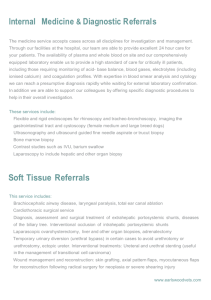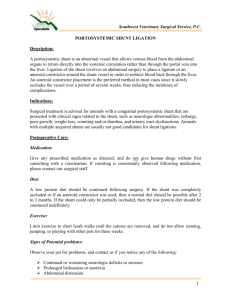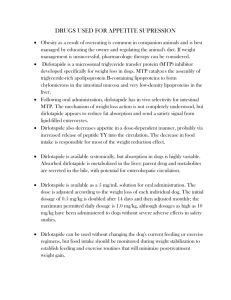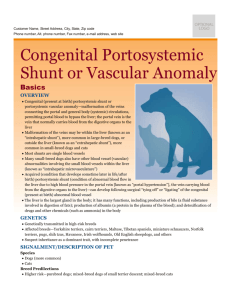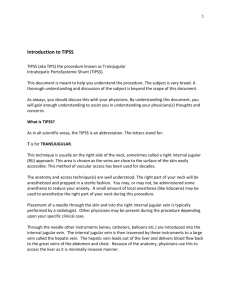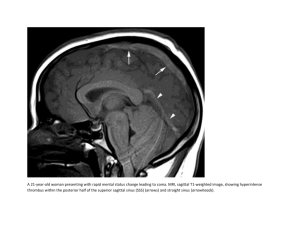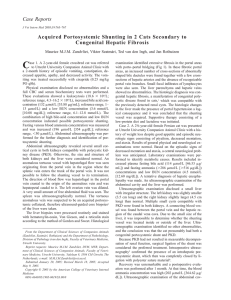September-2011-Shunt..
advertisement
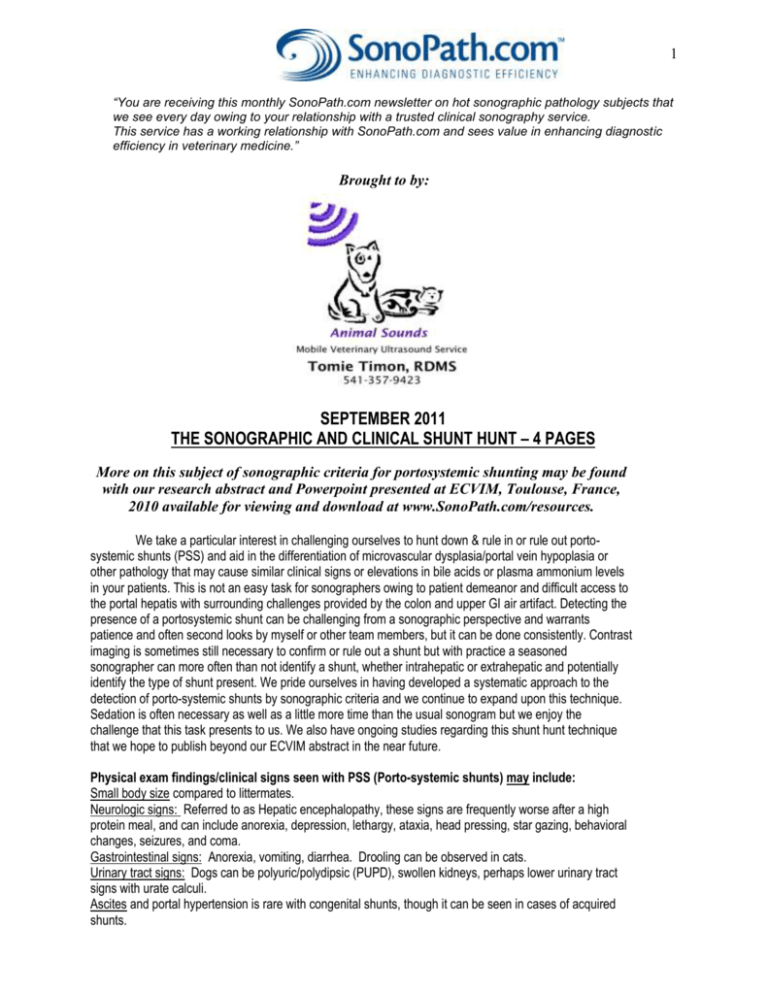
1 “You are receiving this monthly SonoPath.com newsletter on hot sonographic pathology subjects that we see every day owing to your relationship with a trusted clinical sonography service. This service has a working relationship with SonoPath.com and sees value in enhancing diagnostic efficiency in veterinary medicine.” Brought to by: SEPTEMBER 2011 THE SONOGRAPHIC AND CLINICAL SHUNT HUNT – 4 PAGES More on this subject of sonographic criteria for portosystemic shunting may be found with our research abstract and Powerpoint presented at ECVIM, Toulouse, France, 2010 available for viewing and download at www.SonoPath.com/resources. We take a particular interest in challenging ourselves to hunt down & rule in or rule out portosystemic shunts (PSS) and aid in the differentiation of microvascular dysplasia/portal vein hypoplasia or other pathology that may cause similar clinical signs or elevations in bile acids or plasma ammonium levels in your patients. This is not an easy task for sonographers owing to patient demeanor and difficult access to the portal hepatis with surrounding challenges provided by the colon and upper GI air artifact. Detecting the presence of a portosystemic shunt can be challenging from a sonographic perspective and warrants patience and often second looks by myself or other team members, but it can be done consistently. Contrast imaging is sometimes still necessary to confirm or rule out a shunt but with practice a seasoned sonographer can more often than not identify a shunt, whether intrahepatic or extrahepatic and potentially identify the type of shunt present. We pride ourselves in having developed a systematic approach to the detection of porto-systemic shunts by sonographic criteria and we continue to expand upon this technique. Sedation is often necessary as well as a little more time than the usual sonogram but we enjoy the challenge that this task presents to us. We also have ongoing studies regarding this shunt hunt technique that we hope to publish beyond our ECVIM abstract in the near future. Physical exam findings/clinical signs seen with PSS (Porto-systemic shunts) may include: Small body size compared to littermates. Neurologic signs: Referred to as Hepatic encephalopathy, these signs are frequently worse after a high protein meal, and can include anorexia, depression, lethargy, ataxia, head pressing, star gazing, behavioral changes, seizures, and coma. Gastrointestinal signs: Anorexia, vomiting, diarrhea. Drooling can be observed in cats. Urinary tract signs: Dogs can be polyuric/polydipsic (PUPD), swollen kidneys, perhaps lower urinary tract signs with urate calculi. Ascites and portal hypertension is rare with congenital shunts, though it can be seen in cases of acquired shunts. 2 Radiographic findings: The liver is often small in dogs but is most often normal size in cats (SH6). The kidneys may be large in both dogs and cats. If ammonium urate calculi have formed secondary to the hepatic dysfunction, they are commonly radiolucent and not seen radiographically. Contrast portography is often done to confirm the presence of PSSs. The mesenteric vein or the spleen is injected with an iodinated contrast material to visualize the portal vasculature. In a normal animal, the portal vein’s multiple intrahepatic branches will be seen. Variable patterns of shunting are seen with PSSs. Congenital portosystemic shunts (CPSS) are classified as: Intrahepatic: More common in large breed dogs, and involves a shunt between the portal vein (PV) and caudal vena cava (CVC) and may exist concurrently with portal vein hypoplasia (hypoplasia of the portal branches o r portal vein itself) (SH9). These are further classified as left, central or right divisional. Extrahepatic: More common in small breed dogs and cats, involves a shunt from the portal vein, left gastric or splenic vein to the CVC, occurring cranial to the phrenicoabdominal veins. The shunt may occasionally enter the azygous vein dorsally bypassing the vena cava. In dogs, the common origins of the shunt are the left gastric vein, splenic vein, or portal vein. However, according to one study, the portocaval shunt is actually a derivation of the splenic vein . While the left gastrocaval shunt is derived from the anastomosis of the right and left gastric veins (SH15). Gastrocaval shunts usually run along the lesser curvature of the stomach passing the hepatic hilus and enter dorsally into the vena cava cranial to the right phrenic vein. Portosystemic shunts in cats commonly arise from the left gastric vein (SH10). Breed predisposition: Extrahepatic: Miniature schnauzers, Yorkshire terriers, Pugs, Dachshunds, Cairn terriers, Maltese. Intrahepatic: Irish wolfhounds, Australian cattle dogs, Golden retrievers, Old English sheepdogs, Labrador retrievers. Acquired portosystemic shunts (APSS) result secondary to portal hypertension (cirrhotic or noncirrhotic). These shunts represent enlargement of otherwise nonfunctional vessels. They appear as multiple, tortuous vessels that communicate with the CVC in the area of the left kidney. If post-hepatic portal hypertension occurs (right-heart failure), shunting does not result because the pressure in the CVC is elevated as well. Non-shunt pathology that can elevate bile acids (SH 11, 12): Non-hepatic causes: Inflammatory bowel disease/intestinal disbiosis Spontaneous gall bladder contraction Hypertriglyceridemia Ursodeoxycholic acid treatment Severe disease of the ileum or resection (site of bile acid reabsorption) Cholecystectomy Prolonged anorexia Hyperadrenocorticism Pancreatitis Other non hepatic pathology Transient elevation in Irish Wolfhound puppies Hepatic Causes: Diffuse hepatocellular disease Cholestatic disease Microvascular dysplasia/portal vein hypoplasia 3 Note: Fasting plasma ammonium (AMM) and bile acid (BA) profiles were found to be nearly of equal sensitivity in detecting portovenous anomalies ( AMM 100% vs BA 92.2%) in one large study. However AMM was found to be much more sensitive in detecting the presence of either congenital or acquired shunting compared to bile acid testing (AMM 89.3%% vs BA 17.9%) for dogs with confirmed liver disease. (SH 14) When to recommend surgical correction of the shunt and when not to? This has been an interesting discussion in the past few years and we will largely defer to the referenced literature for the reader to draw his/her own conclusions. However, personal experience and logic lead to the following criteria: If the objective of the sonographer/clinician is to maximize the life-long parenchymal integrity and function of the liver in the shunt patient in order to be capable to sustain compromising insults during its lifetime (inflammatory, toxic, neoplastic disease) and still be able to maintain a minimally functional level of parenchyma (30-40% roughly of normal metabolic hepatic size), then we must consider the following: 1) Is there concurrent hepatic, or other concurrent disease that influences the hepatic integrity such as microvascular dysplasia, inflammatory disease, IBD et cetera..) 2) Is the shunt extrahepatic and amenable to ameroid constrictor therapy and is the surgeon, and is the facility where the procedure going to be performed, well versed in surgically treating and managing shunt cases? 3) Is the shunt intrahepatic and necessitates a referral facility capable of fluoroscopic guided closure or other techniques if not surgically correctable by traditional means? 4) A protein C level (available from Cornell University) may aid in this decision as dogs with protein C levels less than 70% have more significant shunting and more significant hepatic failure than dogs with protein C within the normal range. This test may also aid in assessing for improvement in hepatic function post ligation (SH 16). The clinician must also ask the questions: What is the best way to maximize the functional hepatic parenchyma in this particular patient with this particular profile with respect to its current metabolic and clinical state? Should we medically treat and stabilize for eventual surgery? Are there too many complicating factors such as diffuse disease, portal hypertension and ascites that warrant a medical approach alone? Is the shunt surgically correctable and no significantly evident complicating factor is noted, that allows for surgical treatment to potentially maximize the metabolic liver potential of the patient? Has all the shunt literature available been reviewed to draw an adequate conclusion regarding these factors presented for this individual amongst the many potential clinical and sonographic presentations? Only at this point can objective recommendations be given to the owner regarding which therapeutic approach to pursue. References: SH1: Lamb et al. Diagnostic Imaging of Dogs with suspected portosystemic shunting. Compendium vol24, no 8 august 2002 SH2: Lamb et al. Ultrasonographic Diagnosis of Congenital Portosystemic Shunts in Dpgs: Results of a Prospective Study. Vet rad and US Vol 37. No 4, 1996, pp281-288. SH3: Diagnosis and Treatment of Portosystemic Shunts in the cat. Tilson et al. Vet Clin Small Anim 32 (2002) 881-899. SH4: Pancreatic edema in Dogs with Hypoalbuminemia or Portal Hypertension. Lamb. J Vet Intern Med 1999 498-500. SH5: Effect of Breed Anatomy of Portosystemic Shunts resulting from Congenital Diseases in Dogs and Cats: A review of 242 cases. Hunt. Australian Veterinary Journal Vol 82. No 12, Dec 2004. SH6: d’Anjou M, Penninck D, Cornejo L, Pibarot P (2004), Ultrasonographic diagnosis of portosystemic shunting in dogs and cats. Vet Radiol Ultrasound, 45(5),:424-437. SH7: Johnson, SE (2000), Chronic hepatic disorders, In Ettinger, SJ and Feldman, EC (eds), Textbook of Veterinary Internal Medicine, 5th ed., W.B. Saunders Co, 1298-1325. SH8: Szatmári V, Rothuizen J, Voorhout G (2004), Standard planes for ultrasonographic examination of the portal system in dogs. J Am Vet Med Assoc, 244(5), 713-716. SH9: Szatmári V, Rothuizen J, van den Ingh TSGAM, et al. Ultrasonographic findings in dogs with hyperammonemia: 90 cases (2000-2002) (2004). J Am Vet Med Assoc 224 (5), 717-727. Sh10: Nyland TG, Mattoon JS, Herrgesell EJ, Wisner ER (2000), Liver, In Nyland TG and Mattoon JS (eds), Small animal diagnostic ultrasound, 2nd ed, WB Saunders, Co, 93-127. 4 SH11: CVT XII pp739-740, SH 12: Willard Small Animal Clinical Diagnosis by Laboratory Methods 4 th edition pp 241-242): SH 13: Gerritsen-Bruning MJ et al. Diagnostic value of Fasting Plasma Ammonium and Bile Acids Concentrations in the Identification of Portosystemic Shunting in Dogs. J Vet Intern Med 2006;20:13-19. SH 14: Kummeling A. et al. Coagulation Profiles in Dogs with Congenital Portosystemic Shunts before and after Surgical Attenuation. J Vet Intern Med 2006;20:1319-1326. SH 15: Szatmari V et al. Ultrasonographic assessment of hemodynamic changes in the portal vein during surgical attenuation of congenital extrahepatic portosystemic shunt in dogs. JAVMA, Vol 224, No. 3, February 1, 2004. SH 16: Toulza O et al. Evaluation of plasma protein C activity for detection of hepatbiliary disease and portosystemic shunting in dogs. JAVMA 2006;229(11):1761-1771). Best Regards & Happy Hunting! Eric Lindquist DMV (Italy), DABVP K9 & Feline Practice Cert. IVUSS Director NJ Mobile Associates, Founder SonoPath.com COME VISIT US AND LIKE US ON FACEBOOK! "Make every obstacle an opportunity." Lance Armstrong This Communication has Been Fueled By SonoPath LLC. 31 Maple Tree Ln. Sparta, NJ 07871 USA Via Costagrande 46, MontePorzio Catone (Roma) 00040 Italy Tel: 800 838-4268 For Case Studies & More Hot Topics In Veterinary Medicine For The GP & Clinical Sonographer Alike, Visit www.SonoPath.com
